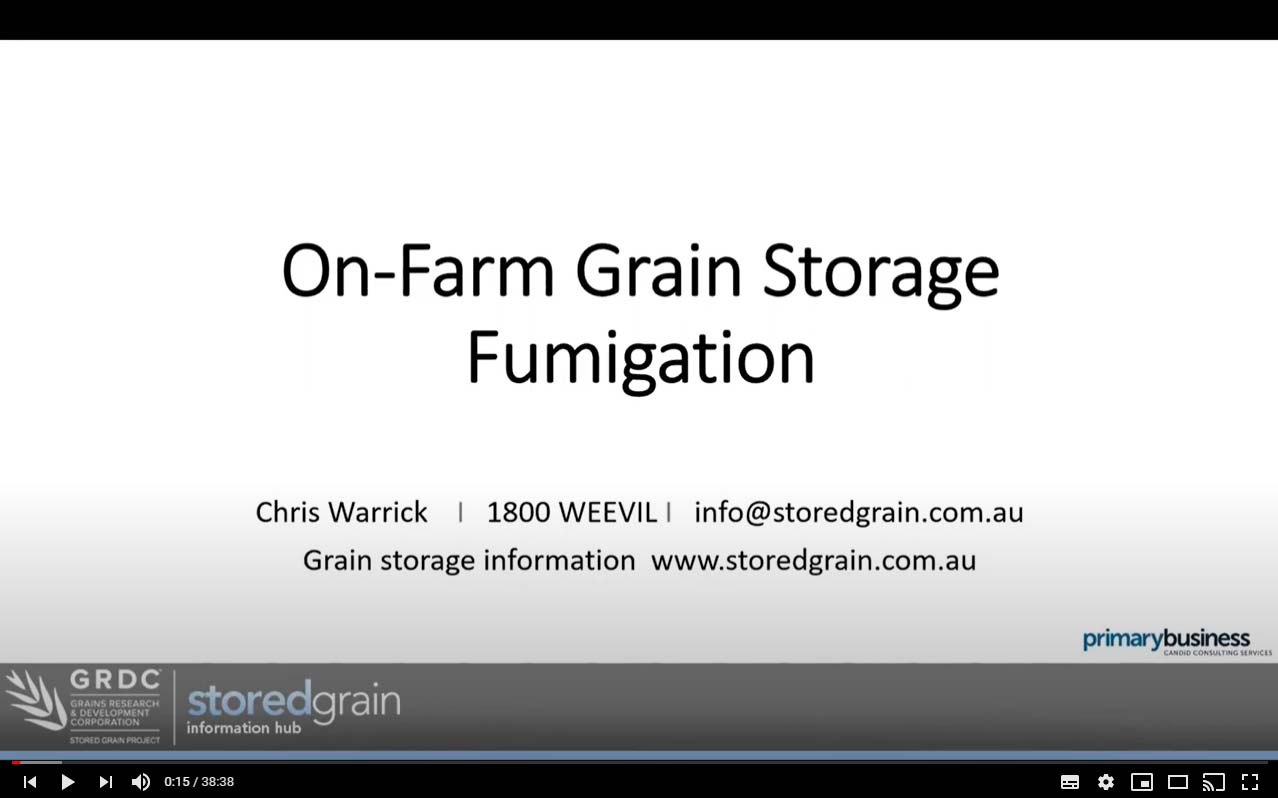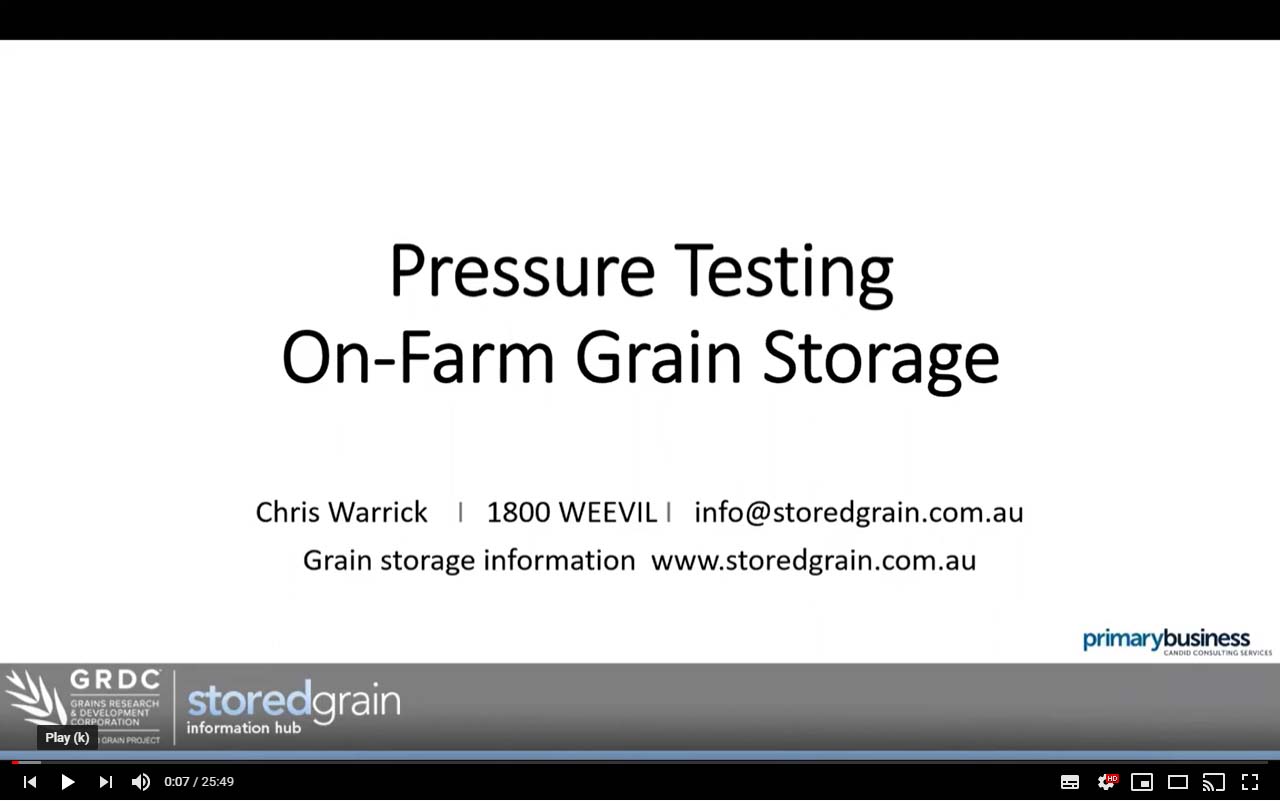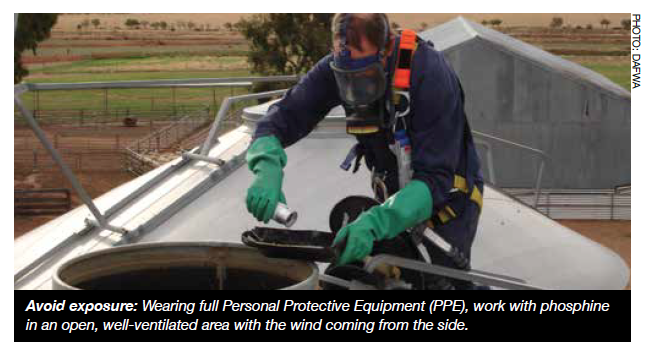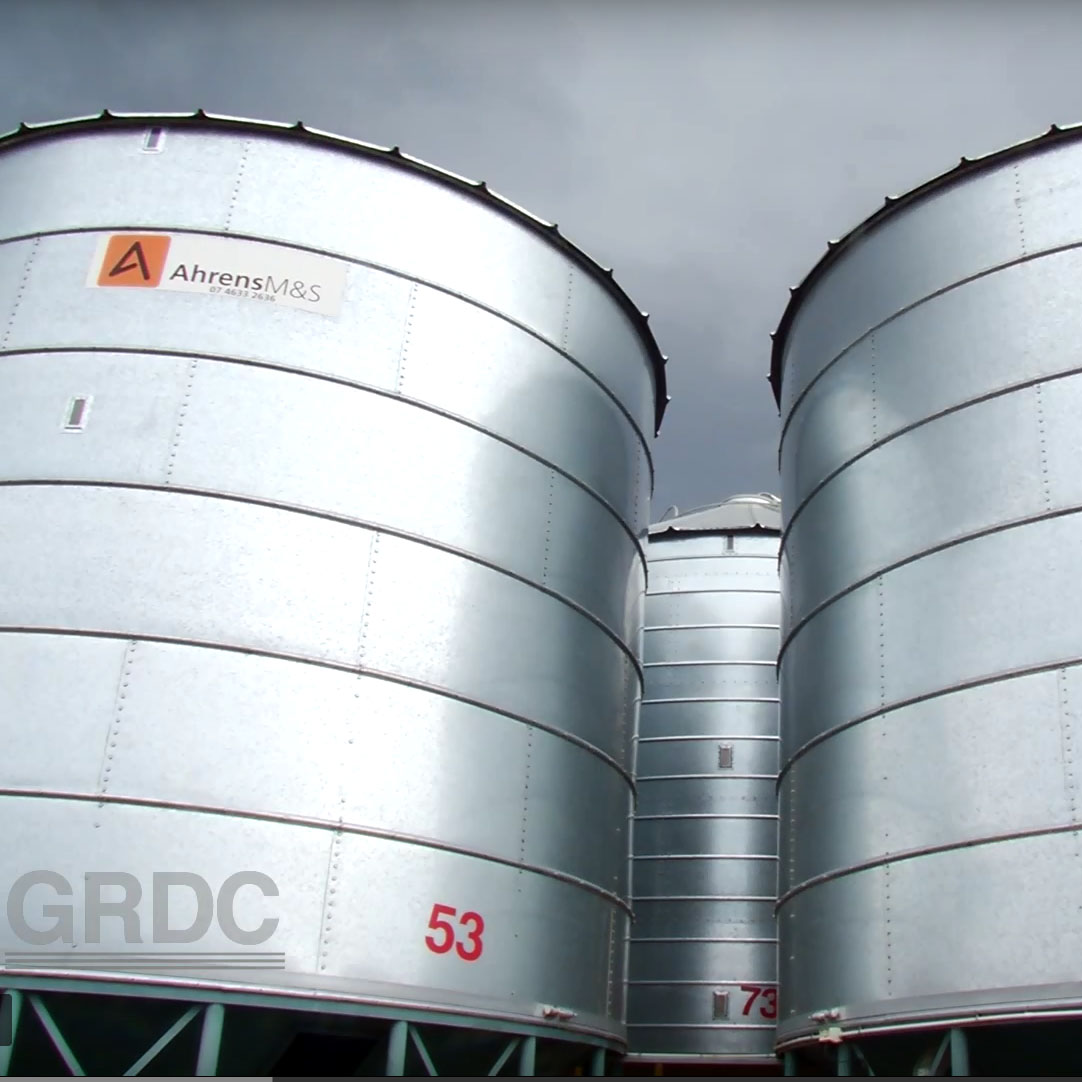Grain storage specialist Chris Warrick presents a webinar on how to perform successful and reliable fumigations with phosphine on farm
Pressure testing silos
Grain storage specialist Chris Warrick presents a webinar on why and how to pressure test on-farm grain storage
Grain Fumigation – A Guide
In order to kill grain pests at all stages of their life cycle (egg, larva, pupa, adult), phosphine gas needs to reach, and be maintained at, a concentration possible only in a gas-tight storage.
Key Points
- To control insects at all life stages the only option is to fumigate in a gas-tight storage.
- Cool grain temperatures require a longer fumigation period.
- Aeration fans fitted on gas-tight silos provide a number of benefits including a shorter ventilation period following a fumigation.
The total time required for effective fumigation ranges from 10–17 days, accounting for the minimum exposure period, ventilation and withholding period. This highlights the importance of monitoring grain regularly and at least 17 days before out-loading to allow sufficient time to fumigate if required.
Rates for success
When determining how much phosphine to apply, it is important to treat the entire storage volume, regardless of how much grain is contained inside. For example, a 100 tonne silo full of grain requires 200 phosphine tablets. If that same 100t silo is only half full of grain, it still requires 200 phosphine tablets for effective fumigation.
Handle with care
Phosphine is a highly toxic gas with potentially fatal consequences if handled incorrectly. As a minimum requirement, the label directs the use of cotton overalls buttoned at the neck and wrist, eye protection, elbow-length PVC gloves and a breathing respirator with combined dust and gas cartridge.
Where to apply
Arrange the tablets where as much surface area as possible is exposed to air, so the gas can disperse freely throughout the grain stack. Spread phosphine tablets evenly across trays before hanging them in the head space or placing them level on the grain surface inside a gas-tight, sealed silo. Hang bag chains in the head space or roll out flat on the top of the grain so air can freely pass around them as the gas dissipates. Bottom-application facilities must have a passive or active air circulation system to carry the phosphine gas out of the confined space as it evolves. Without air movement, phosphine can reach explosive levels if left to evolve in a confined space.
Time to kill
To control pests at all life stages and prevent insect resistance, phosphine gas concentration needs to reach 300 parts per million (ppm) for seven days (when grain is above 25°C) or 200ppm for 10 days (between 15–25°C). Insect activity is slower in cooler grain temperatures so require longer exposer to the gas to receive a lethal dose.
Table 1 – Application rates for phosphine tablets in storage
Gas venting
Following fumigation, ventilate silos so grain can be delivered free from harmful gas residues. With tablet residue or bag chains removed, leave silos open for no less than five days, or no less than one day with aeration fans
operating. The final step is to hold grain for a further two days after ventilation before using for human consumption or stockfeed
Disclaimer
Any recommendations, suggestions or opinions contained in this publication do not necessarily represent the policy or views of the Grains Research and Development Corporation. No person should act on the basis of the contents of this publication without first obtaining specific, independent professional advice. The Corporation and contributors to this Fact Sheet may identify products by proprietary or trade names to help readers identify particular types of products. We do not endorse or recommend the products of any manufacturer referred to. Other products may perform as well as or better than those specifically referred to. The GRDC will not be liable for any loss, damage, cost or expense incurred or arising by reason of any person using or relying on the information in this publication.
CAUTION: RESEARCH ON UNREGISTERED PESTICIDE USE
Any research with unregistered pesticides or of unregistered products reported in this document does not constitute a recommendation for that particular use by the authors or the authors’ organisations. All pesticide applications must accord with the currently registered label for that particular pesticide, crop, pest and region. Copyright © All material published in this Fact Sheet is copyright protected and may not be reproduced in any form without written permission from the GRDC.
Silo Buyer’s Guide
The decision of which silo to buy can be daunting, mainly because it’s a 20+ year investment and not a purchase that is easily returned or traded-in if it proves unsuitable. The following information will help identify the key features to look for when purchasing silos.
Key Points
- Buying silos is a significant, long-term investment – take the time to make the right choice.
- Consider the storage requirements for the next 20 years — not just the next season.
- For reliable insect control and grain quality maintenance, choose a gas-tight sealable storage, which also has aeration.
- Gas-tight sealable storage must meet the Australian Standard AS2628.

Choose carefully: While all silos are made to store grain and ‘do the job’, some will
enable superior grain quality management than others.
Quality in – quality out
Maintaining grain quality during storage relies on the ability to control moisture, temperature and insects. It makes sense to look for storage with aeration cooling as well as being gas-tight sealable for effective fumigation.
While aeration cooling won’t reduce grain moisture significantly, it will prevent moisture migration and lower grain temperature. Properly managed aeration cooling provides cool, uniform conditions throughout the storage, which discourages pest infestation and mould growth and maintains grain quality. An added benefit of aeration is that it can be used to ventilate a silo after fumigation in one day, rather than waiting five days.
Insect pest control
Western Australia has given up access to contact pesticides long ago and the eastern states are under increasing pressure to follow suit to protect our markets. This puts added pressure on fumigants, mainly phosphine, to control pests during storage. In order to control pests at all life stages (eggs, larvae, pupae, adult) and prevent further resistance, phosphine and other fumigants are only effective in a gas-tight storage.
 A little maintenance goes a long way
A little maintenance goes a long way
In the same way that all farm machinery needs regular maintenance to keep it working reliably, so do silos, especially gas-tight sealable silos. A small gas leak can mean the difference between a successful fumigation and insects surviving, leading to loads being rejected upon receival.
Grain hygiene is the other important maintenance component. Well designed silos won’t have areas that trap grain and dust making them quick and easy to clean.
 Find a safe bet
Find a safe bet
The WHS (previously OH&S) spotlight continues to shine on agricultural industries and is undoubtedly here to stay. Consider silos that meet state WHS requirements and more importantly can be safely operated by everyone on site.
While some silos come without ladders, mould and insects are often found in the top of a silo before they can be detected at ground level. The main options are to have an WHS compliant ladder, use a safety harness or build a platform that spans along the top of a line of silos.
Silo purchase checklist
Copyright © All material published in this Fact Sheet is copyright protected and may not be reproduced in any form without written permission from the GRDC. Produced by: www.primarybusiness.com.au
Pressure testing sealable silos
Fumigating with phosphine in unsealed silos does not kill pests at all stages of their life cycle. Repeat fumigations in unsealed silos increases resistance levels and selects for insects with a higher phosphine tolerance. Pressure testing a silo ensures it can hold gas concentrations sufficient to kill all insects at all life stages.
Key Points
- A silo sold as a ‘sealed silo’ needs to be pressure tested to be sure it’s gas-tight.
- It is strongly recommended that growers ask the manufacturer or reseller to quote the AS2628 on the invoice as a means of legal reference to the quality of the silo being paid for.
- Pressure test sealed silos upon erection, annually and before fumigating with a five-minute half-life pressure test.
- Maintenance is the key to ensuring a silo purchased as sealable can be sealed and gas-tight.
What is a sealed silo?
Just because a silo is sold as a sealed silo, does not automatically mean it’s suitable for fumigation.
To some people a sealed silo may be one that keeps rain out or one that is sold labelled as a sealed silo.
A silo is only truly sealed if it passes a five-minute half-life pressure test according to the Australian Standard AS2628. Often silos are sold as sealed but are not gas-tight — rendering them unsuitable for fumigation.
Even if a silo is sold as ‘sealed’ it is not sealed until it is proven gas-tight with a pressure test.
The term ‘sealed’ has been used loosely during the past and in fact some silos may not have been gas-tight from the day they were constructed.
However, even a silo that was gas-tight to the Australian Standard on construction will deteriorate over time so needs annual maintenance to remain gas-tight.
Why do I need to do a pressure test?
In order to kill grain pests at all stages of their life cycle (egg, larvae, pupae, adult), phosphine gas concentration levels need to reach and remain at 300 parts per million (ppm) for seven days or 200ppm for 10 days.
Trials show that these levels of gas concentration are impossible to achieve in silos that are not pressure tested and gas-tight, so insects will not be killed at all life stages. The fumigation may appear successful when the adults die but the surviving eggs and pupae will continue to develop and reinfest the grain.
A pressure test is a measure of how well a silo will seal to contain fumigation gas.
 When to perform a pressure test
When to perform a pressure test
If silos are properly maintained pressure testing does not take long and should be done at three distinct times.
- When a new silo is erected on farm carry out a pressure test at a suitable time of day to make sure it’s gas-tight before paying the invoice or filling with grain.
- Importantly, a silo also needs to be pressure tested when full, before fumigating grain. If the silo has a slide plate outlet that has been tested empty, retest when full to make sure the pressure of the grain doesn’t compromise the seal. The weight of grain can break the seal on the slide-plate outlet where it is not well supported by cams or bolts etc. For older, poorly-designed cone-bottom silos, gentle pressure from a jack may assist the seal. If the weight of grain on the slide plate stops it from sealing, some added pressure from a jack under the silo will assist the sealability.
- Pressure testing silos needs to be part of the annual maintenance. It is much easier to replace seals and carry out repairs when silos are empty.
Carrying out a pressure test
If regular silo maintenance is undertaken to keep seals in working order, pressure testing is easy by following these seven simple steps.
1. Choose the right time to pressure test
 Consider the ambient conditions of the day before pressure testing.
Consider the ambient conditions of the day before pressure testing.
The best time to pressure test silos is in the morning within an hour of sunrise or on a cool, overcast day — when the ambient temperature is stable and the sun is not heating the silo.
Air inside a silo heats and expands as the daily temperature rises and the sun warms the silo walls.
If a pressure test is done when the ambient conditions are changing, air inside the silo expands and gives a false reading.
2. Check seals
Before performing a pressure test check seals around the lid, access hatch, hopper or boot and make sure the aeration fan seal is in a sound condition.
Check to ensure all latches on lids are locked down firmly.
3. If there is no aeration fan – install an air valve
If the silo doesn’t have an aeration fan, install a tubeless tyre valve to pressurise the silo using an air compressor. Unscrew the centre of the valve to get higher air-flow into the silo.
Alternatively for larger silos or if the air compressor is too small, install a PVC male fitting that can connect to a venturi gun (Blovac) that fits on the end of the air line.
4. Check oil levels
 Some sealable silos do not have a gauge on the oil relief valve. If this is the case mark the start and finish oil levels with a pen.
Some sealable silos do not have a gauge on the oil relief valve. If this is the case mark the start and finish oil levels with a pen.
Oil relief valves can be bought and fitted, or a piece of clear tube connected to a second air valve fitted to the silo will suffice.
Before pressurising the silo, check the oil levels are equal on both sides of the gauge and are at the middle indicator mark as shown below.
5. Pressurise the silo
 If fitted with an aeration fan, pressurise the silo by turning the fan on for a few seconds, then sealing the inlet on the fan.
If fitted with an aeration fan, pressurise the silo by turning the fan on for a few seconds, then sealing the inlet on the fan.
This job is easier with two people —one to operate the fan and the other to watch the oil gauge and look for leaks, see step 7.
As soon as the oil levels are more than 25mm apart, or the oil is bubbling, stop the aeration fan and close off the fan inlet immediately. Be careful — there is potential for damage if fans are left running for extended periods while the silo is sealed or with the inlet blocked off.
If the silo doesn’t have an aeration fan, use the tyre valve and an air compressor to pressurise the silo. An air-operated venturi gun, such as a Blovac, with connection fittings to the silo can also be used.
6. Time the half life
 Wait until the pressure drops and the oil levels are 25mm apart (aligned with top and bottom marker).
Wait until the pressure drops and the oil levels are 25mm apart (aligned with top and bottom marker).
The time taken for the oil to drop from 25mm to 12mm apart must be no less than five minutes on new silos.
For older silos three minutes is acceptable.
Whether it is three or five minutes, this process is known as the half-life pressure test.
7. Looking for leaks
 If the the half-life pressure test on a new silo is less than five minutes, there is a leak that needs fixing. If an existing silo does not meet a three minute half-life pressure test, it as a leak that needs fixing.
If the the half-life pressure test on a new silo is less than five minutes, there is a leak that needs fixing. If an existing silo does not meet a three minute half-life pressure test, it as a leak that needs fixing.
To find leaks, pressurise the silo again and use soapy water in a spray bottle to check for air leaks around seals.
Common places for leaks are: bottom outlet, aeration inlet seal, damaged lids (caused by the auger when lining it up to fill the silo), stretched springs on latches, between the bottom cone or base and the silo wall joint, the roof and wall joint and where the lid ring joins the roof.
Cone-bottom silos with a slide plate outlet can be sealed by adding a small amount of pressure to the slide plate with a jack.
Older silos may require more extensive maintenance to achieve a gas-tight seal. When the leak has been fixed, pressurise the silo again and redo the half-life test — steps five and six.
Australian standard for sealed silos
A benchmark for sealing grain silos has been developed to boost the effectiveness of pest control.
Standards body SAI Global published an Australian standard for gas-tight sealed silos in response to industry concerns that phosphine fumigation performed in improperly sealed storages was not killing off the full life cycle of pests.
Resistance to phosphine has increased over the past 10 years with many grain silos failing to meet the gas-tight standard required for effective fumigation.
Resistance to phosphine in target insect pests has increased in frequency and strength threatening effective control.
The standard is based on a new silo meeting a five-minute half-life pressure test. When a pressure test is undertaken, oil levels in the pressure relief valve must take a minimum of five minutes to fall from 25mm to a 12.5mm difference if the silo is sufficiently gas-tight.
The standard allows growers to refer to an industry benchmark when choosing to buy a sealable silo. It is strongly recommended that growers ask the manufacturer or reseller to quote the AS2628 on the invoice as a means of legal reference to the quality of the silo being paid for. Ultimately, this gives growers confidence they have invested in a silo that will perform in the way it is intended. That is, work as a gas-tight chamber and hold a lethal concentration of gas for the time specified on the label, for control of insects at all life stages.
This will prolong the life of phosphine rather than add to the already increased level of resistant insects.








